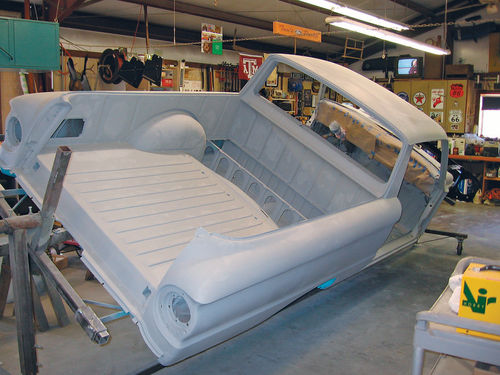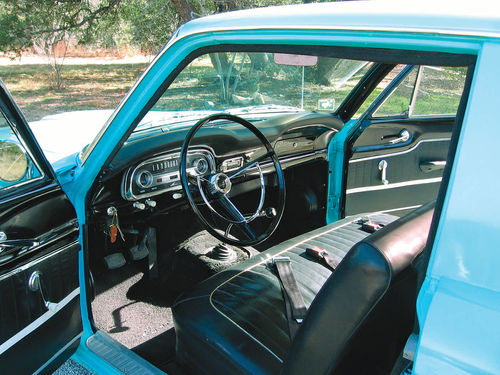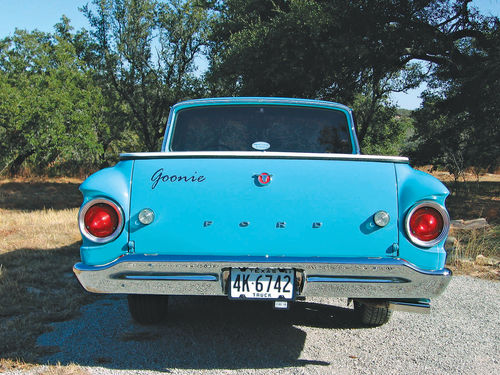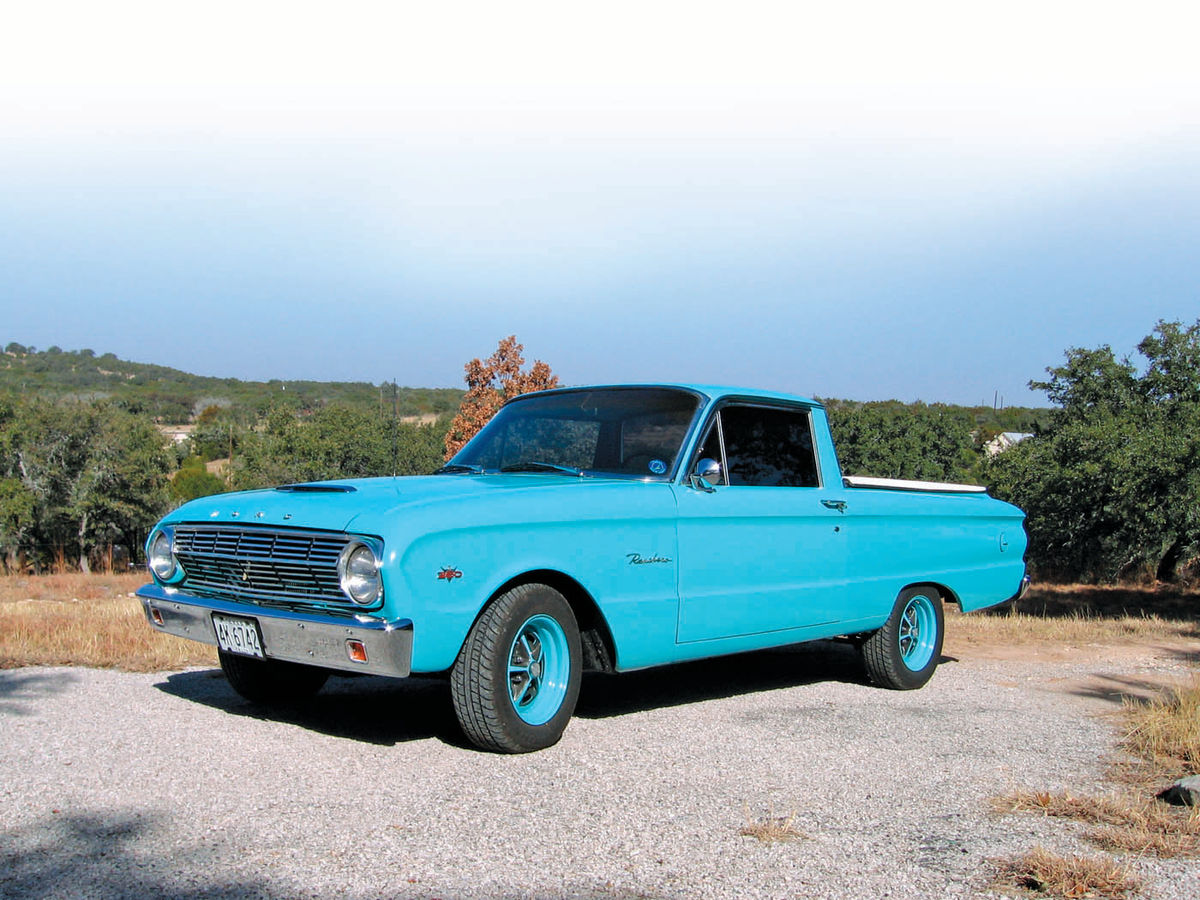1963 Ford Falcon Ranchero
This Rare Truck Was Bought New By His Family and Kept for Decades. So Once It Was Restored, It Was Only Natural That It Would Be Named “Goonie.”
IN AUGUST OF 1963 my grandfather (at age 66) decided that he needed a new pickup to replace his aging Studebaker truck. He also drove a ’59 Studebaker Silver Hawk, so the new truck was not to be his primary driver.
On August 26, 1963 he went to Al Eames Ford, the Ford dealer in Antioch, California, and purchased a ’63 Falcon Ranchero. But he wasn’t after the standard 6-cylinder with a three on the tree. Instead, he bought a “peacock blue” truck with the 260 V-8 engine and 4-speed transmission, AM radio, single-speed electric wipers, backup lights, an upgraded interior and padded dash, but no seatbelts or air conditioning.
My Introduction to the Ranchero
In August of 1969 my new bride and I flew to California for our honeymoon. Granpap let us use the Ranchero while we were there to tour Northern California. We drove it north to the Redwoods and then to a cabin on Echo Lake (near South Shore Lake Tahoe).
Lengthy trips and heavy hauling were regular fare for the Ranchero. One of Granpap’s primary uses for the truck was his bi-annual wine-buying trips throughout the Napa valley and gold country. He would return with the bed filled with cases of wine from Krug, Martini Bros., etc.
When he reached his late ’80s, Granpap chose not drive the truck anymore, so he gave it to his son, Buster. Uncle Buster and his family used it to haul firewood and boats to and from the cabin at Echo Lake, along with lumber, garden bark, gravel (which overloaded the springs), sack concrete and mixer. It was not an easy life for the little Ranchero. During this time Uncle Buster swapped the truck’s rear end for a sedan rear end for better highway speed and gas mileage. The truck was repainted metallic blue after an “encounter” with a rototiller and the engine was rebuilt at 75K to run on unleaded gas.
About eight years ago the Ranchero was parked, covered with a tarp, and only started and driven occasionally. Cousin Ted became the owner after Uncle Buster passed away in 1995, and he had intentions of restoring the Ranchero. He even began gathering parts. Ted also determined that the rebuilt carburetor was not correct for the 260 and after some research found Pony Carburetor that had the proper unit. (Pony Carburetor is now owned by Champion Carburetor of Arlington, Texas; championcarburetor.com.)
The Truck Heads My Way
I had previously restored a ’30 Model A pickup, a ’31 Model A Deluxe Roadster and a ’31 Model A Victoria (seen in the June 2011 Auto Restorer) and thought I was done, but my brother-in law suggested that perhaps one more restoration was in order.
I contacted Cousin Ted, who was involved with a BMW restoration and still had the Ranchero on the shelf. I asked him what he had planned for the “yard art” in the driveway and said that I needed a project. He had seen my work, so after a bit of deliberation and my sharing of the transportation cost, he agreed to ship the truck to my home in Texas. Before that could happen, however, he had to get it drivable, as the transport truck could not negotiate the narrow roads leading to the Ranchero’s location, and the nearest pickup point was three miles away. So, the brakes were made operable and the fuel tank was cleaned, sealed and painted.
I should add that Cousin Ted gave the truck to me with two conditions…if I die before him, he gets the Ranchero back, and he got to keep the original rear license plate.
Say, It Really Is a Rare One
During the time that I was waiting for the truck to arrive, I was surfing the web for information and Falcon/Ranchero sites. One site, (http://63-v8-4speedranchero.s5.com/registry.htm) said that of the 18,533 Rancheros built during the 1963 model year, Granpap’s old truck was one of approximately 135 produced with a V-8 and a four-speed. Wow! I wonder if he realized that he was driving a truly rare vehicle all those years.




The Ranchero arrived in Dripping Springs, Texas, on May 13, 2011, and deconstruction began. At the time, the truck’s odometer showed 1610.7 miles. It had turned over once, barely.
Ted shipped six boxes of parts he had acquired over five years of swap meet picking, and for me it was like Christmas in May. The items included a headliner, refurbished front grille and headlight bezels, stainless bed rails, wiring harnesses, a fuel pump, brake parts, an original exterior mirror, windshield and door gaskets, and shop manuals.
Time for Some Heavy Work
The running gear was removed and the truck was put on a rotisserie that I had built for the Ranchero by a neighbor. All glass, front fenders, seats, doors, bumpers, tailgate, etc. were removed.
The only major rust items, caused by the failure of the windshield wiper seals, were the floor pans so they were cut out and replaced.
Dents were hammered out…the wheel wells were the worst due to the abuse from the firewood loading.
The 50-year-old undercoating was another problem. I found that a needle scaler from Harbor Freight was the perfect tool. I also used it to remove the huge excess of seam filler and hardened grease/dirt from the engine compartment and various parts. (Harbor Freight describes the tool this way: “Attach this air needle scaler to your compressor air line and watch as 19 hardened steel needles power off weld flux, rust, scale, paint, cement and other residues. The air needler is ideal for use with hard, durable, irregular surfaces that can withstand a heavy scouring. Use the air needle scaler to prep hard surfaces in a hurry.”)
Being able to work the metal standing up with the truck on the rotisserie was a lifesaver. Later, the rotisserie, with the truck on its side, also allowed me to rewire the dash sitting on a 5-gallon bucket in the driver’s door opening. That’s a lot better than being on my back on the floorboard.
I also must say that hearing protection was a must during parts of this project.
The entire truck was stripped to bare metal and epoxy primed with PPG DPLF. Minor dents were filled, followed by the application of PPG NCP271 sandable primer, and PPG DCC Concept acrylic urethane “Peacock Blue,” single-stage.
Bumpers were straightened and re-chromed. The rear bumper was a mess from a trailer hitch, mounted to the bumper with a cross bar to the frame. The bumper was deformed and the frame attachment point was cracked.
A Few Additions of My Own
My only upgrades are the Monte Carlo bar, AM/FM stereo and the Protect-O-Top bed cover.
After joining the national Falcon Club, I saw in their magazine that a guy in California had the Protect-O-Top for sale.
I called and he said he had purchased the original molds and found two guys that did the fiberglass work and was selling the tops for about $900, but the shipping would be an additional $400.
He then told me there were two other Austin-area folks who were interested in the tops. I contacted them, we combined our order and we each saved a bunch on the shipping.
Driving My “Mustang Pickup”
Two years, one month and three days after its arrival in Texas, the Ranchero was back on the road. When you look at the photos, note that the seats and door panels are original (50 years old).
The drive is great, with lots of power. We live in the country about 12 miles from town, so on good weather days I drive it for my errands and also use it to participate in club events. I’d say it’s kind of like a Mustang pickup.
One other thing. Why is the word “Goonie” on the tailgate? Easy…that was Granpap’s nickname.
















